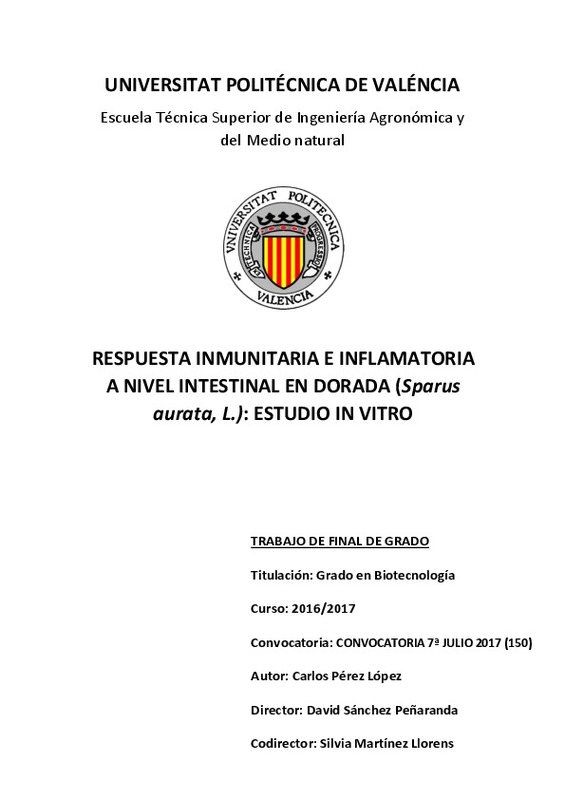|
Resumen:
|
[ES] La necesidad de reducir gastos en la producción acuícola, ha hecho que en los últimos años se
hayan buscado alternativas alimenticias para los peces, las más estudiadas y que presentan un
mayor potencial son los ...[+]
[ES] La necesidad de reducir gastos en la producción acuícola, ha hecho que en los últimos años se
hayan buscado alternativas alimenticias para los peces, las más estudiadas y que presentan un
mayor potencial son los sustituyentes de origen vegetal. Se han realizado numerosas
investigaciones en las que se han estudiado distintas plantas (girasol, soja, garbanzos…) como
posibles fuentes proteicas y lipídicas, tanto parciales como totales. En este estudio se quiso
confirmar in vitro los resultados obtenidos in vivo en un trabajo anterior en el que se estudiaba
el efecto de la sustitución total de los componentes animales en los piensos por componentes
vegetales en la composición de la microbiota intestinal en dorada (Sparus aurata, L.), en el que
se produjo un incremento en la mortalidad de los peces y un aumento en la inflamación
intestinal. Los objetivos de este estudio fueron la puesta a punto para la realización de este
análisis in vitro y el posterior análisis del efecto de una dieta con una composición total de
ingredientes de origen vegetal (VM) en comparación a una dieta comercial basada en harina de
pescado (FM), utilizando tres retos bacterianos: Vibrio alginolyticus, Photobacterium damselae
sbsp Piscicida y Pseudomonas anguilliseptica.
Para la puesta a punto se determinó mediante la prueba LDH, a partir de peces alimentados con
una dieta comercial, cuanto tiempo mantenía el tejido su integridad en el medio Dulbecco
Modified Eagle Medium (DMEM), empleado para el análisis posterior. Además se evaluó la
calidad del ácido ribonucleico (RNA) mediante el análisis de diferentes genes de referencia. La
capacidad del tejido a responder al reto en base a la dieta administrada al pez previamente al
sacrificio, se evaluó mediante el análisis de la expresión génica de genes relacionados con
procesos inflamatorios (IL-1β, IL-6 y COX-2), de respuesta inmune (I-muc e IgM) e integridad
(Ocl).
Las pruebas realizadas para la puesta a punto determinaron que se podía trabajar hasta las 6
horas en el medio DMEM sin que la calidad del tejido y del RNA se viese afectada. A las 6 horas
se produjo una respuesta inflamatoria tras la exposición al reto bacteriano con Vibrio
alginolyticus, además de una respuesta inflamatoria en los tejidos de peces alimentados con la
dieta VM.
Estos resultados permitieron confirmar la inflamación producida por la alimentación con VM
en el estudio in vivo, así como determinar que la muerte de los peces en el estudio anterior fue
debido a la variación de la microbiota intestinal consecuencia de una inmunosupresión al
alimentar los peces con VM.
[-]
[EN] The need to reduce costs in aquaculture production has made that in recent years it has been
searched food alternatives for fish, the most studied and the greatest potential are plants
substitutes. Many researchers ...[+]
[EN] The need to reduce costs in aquaculture production has made that in recent years it has been
searched food alternatives for fish, the most studied and the greatest potential are plants
substitutes. Many researchers have been made in which it has been studied different plants
(sunflower, soybean, chickpeas ...) as possible protein sources and lipids substitutes, both
partial and total. In this study we wanted to confirm in vitro results obtained in a previous in
vivo work in which the effect of the total substitution of the animal components in the
fishmeal by vegetal components, in the composition of the intestinal microbiota in the gilthead
sea bream (Sparus aurata, L.), in which there was an increase in fish mortality and an increase
in intestine inflammation. The objectives of this study were the set-up for the realization of
this in vitro analysis and the subsequent analysis of the effect of a diet with a total composition
of ingredients of plant origin (VM) in comparison to a commercial diet based on fish meal (FM),
using three bacterial challenges: Vibrio alginolyticus, Photobacterium damselae sbsp Piscicida
and Pseudomonas anguilliseptica.
For the set-up, the LDH test was determined, from fish fed a commercial diet, how long the
tissue maintained its integrity in Dulbecco Modified Eagle Medium (DMEM), used for the
subsequent analysis. In addition, the quality of ribonucleic acid (RNA) was evaluated by the
analysis of different house keeping. The ability of the tissue to respond to the challenge based
on the diet given to the fish prior to slaughter was evaluated by the analysis of the gene
expression of genes related to inflammatory processes (IL-1β, IL-6 and COX-2) Immune
response (I-muc and IgM) and integrity (Ocl).
The tests performed for the set-up determined that it was possible to work up to 6 hours in
the DMEM medium without the quality of the tissue and the RNA being affected. After 6
hours, an inflammatory response was reported after exposure to bacterial challenge with
Vibrio alginolyticus. In addition, an inflammatory response was reported on the tissues of fish
fed with the VM diet.
These results allowed to confirm the inflammation produced by the feeding with VM in the
study in vivo, as well as to determine that the death of the fish in the previous study was due
to the variation of the intestinal microbiota consequence of an immunosupression when
feeding the fish with VM.
[-]
|







